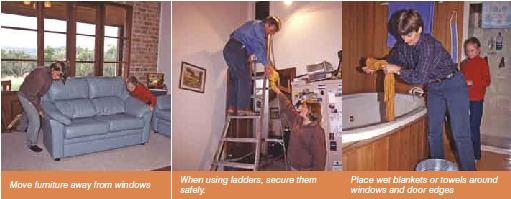Project Contacts
Contact Us
Actively defending a well prepared house.
A house is far more likely to survive if able-bodied people are there during the bushfire because they can quickly put out small outbreaks on or near the house. Most houses burn down from ember attack after the fire front has gone through.
However, to actively defend you need to make sure that you have:
- Prepared your house and property
- Created a defendable space with dry vegetationalready removed from around the house
- Checked that your fire fighting equipment is in good working order and know how to use it
- Provided personal protective clothing for all members of your household
- Considered yourself as being emotionally andphysically able to defend.
Property and house preparedness should be an annual event, preferably before the start of summer and the fire season. Most people who are threatened by bushfire will not have time to increase their preparedness before the fire impacts on their home.
Residents must keep in mind that in a major bushfire, CFA will not be able to provide assistance to every home.
There may also be private vehicles involved in fighting the fire. Should you plan to assist in the fire fighting effort, please consider the safety of your house and yourself before leaving your property. CFA has produced the booklet Operating Private Equipment at Fires. Be familiar with the guidelines before assisting in the fire fighting effort. These can be found on www.cfa.vic.gov.au.
- Your house and property have to be prepared well before the day of the fire threat
Before the fire front arrives Inside:
- Dress in personal protective clothing to protect from;radiant heat
- Shut all windows and doors to prevent smoke and;flames from entering the house
- Move furniture away from the windows to prevent;embers from entering the house through a broken;window and catching alight in the furniture
- Secure a ladder under the manhole and place a torch;nearby for checking the ceiling space for any embers;that may have landed
- Fill the bath, laundry trough and buckets with water to;provide a water supply in the house for putting out any;small fires that may start
- Cover your face with a cotton handkerchief to protect;against smoke inhalation
- Place wet blankets or towels around window and door;edges inside the house to stop smoke and embers;from entering the house

Outside:
- Check water supplies around your home and fill any;additional containers
- Remove or place inside garden furniture, doormats;and other loose items that could trap embers
- Hose down the side of the house facing the fire, and;garden area close to the house
- Block downpipes and fill gutters with water
- Patrol your property for any embers and extinguish;them using mops and buckets of water, backpack;sprayers or a fire pump
- Turn on your sprinkler system if there is one installed
- Listen to ABC radio for regular updates of the fire;situation
Most roofs will not burn, so don’t get up on your roof to hose it down as wet roofs are slippery and can be dangerous.
During the fire:
Go inside when it becomes too hot to stay outside. The skin on your ears and hands will alert you that conditions have become too hot to survive outside. Your home will protect you from radiant heat while the fire front passes through – typically taking around ten to twenty minutes.
Take all fire fighting equipment inside with you, including tap fittings, hoses and the portable fire fighting pump, as these items may become very hot and even melt as the fire front passes through.
Stay inside your house while the fire front passes around the house and look out for burning embers landing inside the home. Extinguish any spot fires that start. Do not hide or take shelter in a part of your house where it is not possible to see the progress of the fire. Keep a watch of the situation and return outside as soon as the main fire front has passed to extinguish any small fires that may have started.
If your house catches fire during the passage of the main fire front and you are unable to extinguish what has now become, in effect, a house fire, go outside onto burnt ground after the fire front has passed. Keep well away from the radiant heat that is being generated from the structure fire. Do not return inside the house for any reason.
After the fire front has passed
Continue to wear your personal protective clothing and go outside again as soon as it is safe. Safely water down the outside of the house, including the roof, and look out for small fires around your house.
Continue to look out for small fires and burning embers many hours after the fire has passed.
Check for burning embers:
- inside the roof
- under the floor boards
- under house spaces
- on verandas and wooden decking
- on timber window ledges and door sills
- on roof lines and in roof gutters
- around outdoor furniture
- on doormats
- in garden beds and mulch
- in wood heaps
- in sheds and carports
What to expect during a bushfire:
- Hot weather
- A lot of smoke and noise
- Loss of power and water
- Loss of phone
- Fire trucks and aircraft nearby
Try to:
- Keep calm
- Take breaths
- Drink plenty of water
Defending you home during a bushfire can be a very frightening and emotional experience. The conditions will also make it physically demanding.
-
The MCRN Office does not have regular opening hours.
please call 0458 626 210 between 9am and 4pm Mon-ThursEmail: emanager@mcrn.org.au or support@mcrn.org.ausubmit an online query using the form provided To contact thebr
Resilient Villages Project Team: resilience@mcrn.org.au
